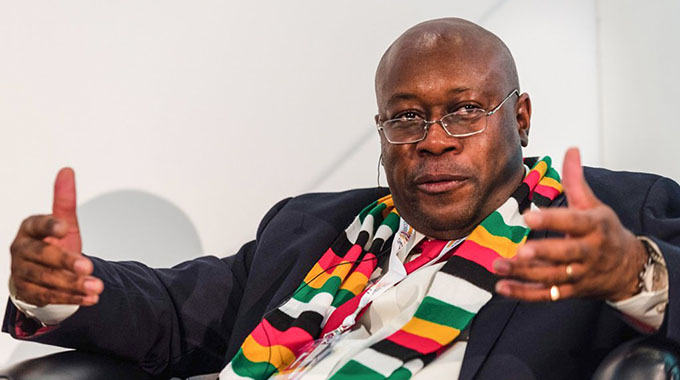Gold centres to drive small miners’ output

Oliver Kazunga Senior Business Reporter
THE establishment of gold centres and availing funding facilities to support artisanal and small-scale mining activities towards realisation the US$12 billion milestone, one of the key deliverables of the National Development Strategy 1 (NDS 1).
This was said by Mines and Mining Development Minister Winston Chitando during the launch of the US$10 million Gold Facility by Finance and Economic Development Minister Professor Mthuli Ncube in Harare yesterday.
He said the facility coupled with a number of mine development and expansion projects targeted at ramping up production by large scale mining firms that include Eureka, Blanket Mine, and Pickstone Peerless, will ultimately boost the country’s total gold output.
The US$10 million gold facility is split into two parts made up of US$5 million for the Artisanal Gold and Small-scale Miners Fund (AGSMF) and another tranche of US$5 million targeted at the Gold Service Centres Recovery Facility.
The gold facility is aimed at supporting artisanal and small-scale gold miners who produce 60 percent of the bullion in Zimbabwe availing revolving fund for mechanisation as well as establishment of the gold service centres to support activities in the sub-sector.
Last year, the small-scale mining industry contributed 69 percent of the record 35,3 tonnes of gold delivered to Fidelity Gold Refiners, Zimbabwe’s exclusive buyer of the bullion produced in the country.
“Today is quite pleasing as we have come to a stage where the money is being made available to support the artisanal and small-scale mining sector in gold through two interventions which were outlined.
“Firstly, through the roll-out of the gold centres but also the second intervention which is to increase the amount of money available to apply as loans to the small- and artisanal mining sector, and that’s the facility which will be administered by the Mining Industry Loan Fund.
“One of the ministry deliverables under the NDS 1 is the establishment of gold centres and this helps significantly towards the ministry moving towards attainment of that object,” he said.
Through the US$5 million Gold Service Centres Recovery Facility six centres will be established of which five of them will be in Makaha (Mutuko), Penhalonga, Mazoe, Mt Darwin and at site yet to be identified in Midlands province.
The Mining Industry Loan Fund, which is administered by the Ministry of Mines and Mining Development would see artisanal and small-scale miners applying for equipment with a pay-back period of a minimum of six months to a maximum of three years.
The vetting of the applicants as has been the case, Minister Chitando said would be done at provincial level where the assessments are done by technical teams under the oversight of the provincial mining director.
“Over and above the security that the Government will avail, the miners will also be expected to provide a form of security as a way of showing commitment towards the project.
“The ministry has been using the hypothecation of the mining title of pledging the claims as collateral in the event of non-payment by the beneficiaries.
“With this intervention (US$10 million Gold Facility) we expect that the total production will increase, not necessarily the percentage because we also have a number of significant initiatives, which will result in an increase in production from the large-scale mining sector,” he said.
“All this as we move to achieve the US$12 milestone by the end of 2023, all this as we move to achieve the 2030 Vision of Zimbabwe being an upper middle-income economy and the vision to be an upper middle-income economy is not an event but a process.”
Officially launching the US$10 million Gold Facility, Prof Ncube noted that the yellow metal is the country’s top foreign currency earner and thus the Government has targeted to allocate resources from the Special Drawing Rights (SDRs) to strategic sectors such as mining expansion and value addition.
The International Monetary Fund (IMF) allocated Zimbabwe US$956 million equivalent of SDRs as part of a general allocation of US$650 billion that was released globally to all of the multilateral institution’s member countries.
“It is from these resources that the Treasury is targeting strategic sectors such as mining expansion and value addition, the mining sector has potential to generate even more in terms of foreign currency earning.
“It’s already the largest foreign currency earner but can do more and to create more jobs that have a multiplier effect in growing our economy,” said Prof Ncube.
“The gold facility has the potential to close the funding gap and spearhead increased productivity as well as finance bankable projects with a focus on value addition.
“Such strategic deployment of resources will ensure that Zimbabwe’s Vision 2030 remains on course as we target a knowledge driven and industrializing upper middle-income society by 2030.”
Official statistics from the Ministry of Finance indicate that Zimbabwe’s total exports increased from US$889,1 million in 2008 to US$5,1 billion by 2021.
The exports grew by an average growth rate of 39,1 percent per annum for the period 2008 to 2021.
Zimbabwe’s top mineral export increased from US$1,2 billion in 2020 to US$1,7 billion in 2021.
The 42 percent increase in 2021 is due to increased gold output and firm prices as global economies recovered from the Covid-19 lockdowns.










Comments